So, you’re ready to take the plunge into home fitness? Fantastic!
That decision alone is a huge step. But now comes the next hurdle – what equipment will actually get you moving, keep you engaged, and not end up as a very expensive clothes rack?
If you’re nodding along, let me introduce you to a trusty, effective, and surprisingly versatile companion – the exercise bike.
When it comes to choosing an exercise bike for beginners, the options can seem dizzying, but fear not.
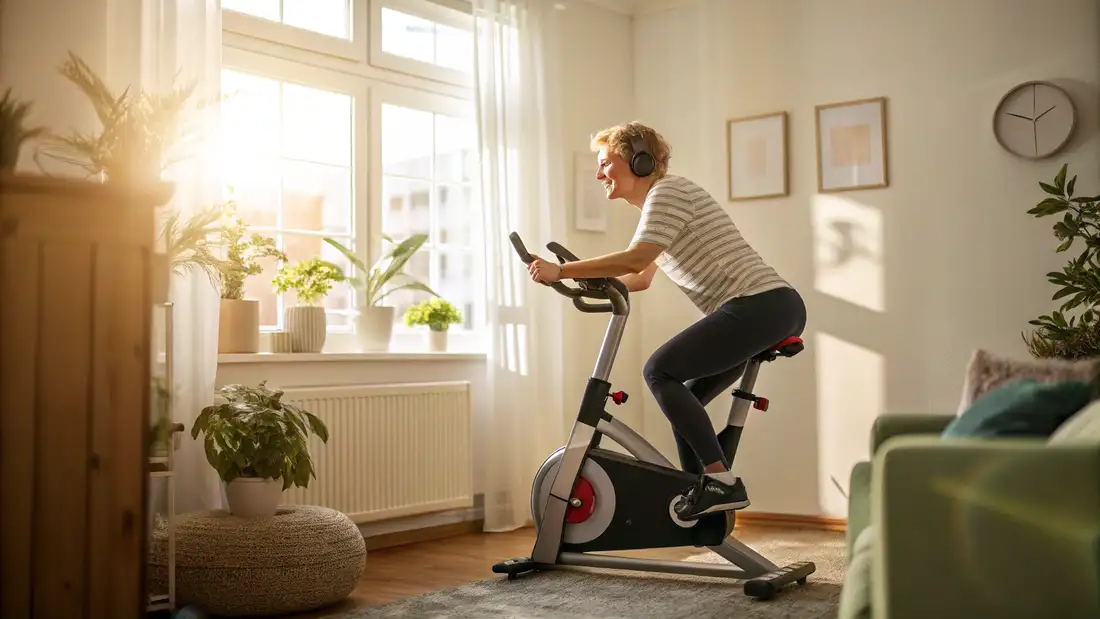
This guide is your friendly co-pilot, here to navigate the terrain of flywheels, resistance types, and seat adjustments, ensuring you find the perfect ride to kickstart your fitness journey from the comfort of your home.
We’ll pedal through everything from why an exercise bike is a stellar choice for newcomers to demystifying the different types available.
We’ll pinpoint the essential features you actually need (and which ones you can probably skip for now), guide you through a pain-free setup, and even get you started with your first few invigorating workouts.
Ready to roll?
Why an Exercise Bike is a Smart First Move for Your Home Fitness Journey
Before we dive into the nuts and bolts of different models, let’s talk about why an exercise bike often takes poll position for beginner home fitness enthusiasts.
It’s not just about convenience (though that’s a massive plus!).
- Kind to Your Joints: This is a big one. Unlike pounding the pavement, cycling is a wonderfully low-impact exercise, meaning it’s gentle on your knees, hips, and ankles. If you’re new to working out, carrying a few extra pounds, or have pre-existing joint sensitivities, this is a game-changer.
- Cardiovascular Champion: Get ready to boost your heart health! Regular cycling strengthens your heart, improves lung capacity, and can contribute to lower blood pressure and a reduced risk of chronic diseases. It’s a fantastic way to build endurance.
- Weight Management Ally: Let’s be honest, for many beginners, weight management is a key goal. Exercise bikes are calorie-torching machines. A moderate 30-minute session can burn a significant number, aiding in creating that all-important calorie deficit for weight loss when paired with a balanced diet.
- The Ultimate Convenience: No gym commute, no waiting for machines, no worrying about the weather. Your bike is ready when you are – be it a pre-dawn pedal or a late-night stress buster. This accessibility dramatically lowers the barrier to sticking with a routine. I remember when I first got mine; the sheer ease of hopping on for 20 minutes after work, without the whole “pack a gym bag” ritual, made all the difference.
- Tones More Than You Think: While primarily a lower-body workout targeting your quads, hamstrings, glutes, and calves, you’ll also engage your core for stability, especially on upright and spin bikes.
Decoding the Ride – Understanding the Main Types of Exercise Bikes
Alright, let’s get to the heart of choosing an exercise bike for beginners.
The first major decision point is the type of bike. Each has its own feel and benefits, catering to different preferences and needs.
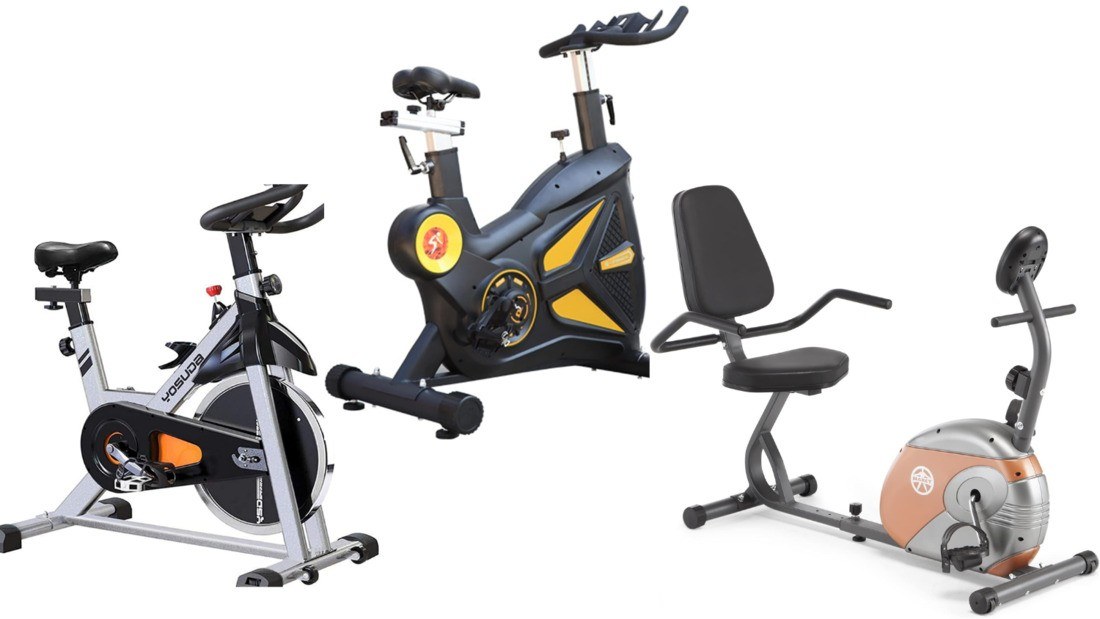
Upright Bikes – The Classic Choice
What it is: These are what most people picture – you sit upright, much like on a traditional outdoor bicycle, with pedals directly beneath you.
Pros for Beginners:
- Familiar Feel: If you’ve ridden a bike before, the posture will feel natural.
- Core Engagement: The upright position requires more core stabilization.
- Space-Saving: Generally have a smaller footprint than recumbent bikes.
Cons for Beginners:
- Seat Comfort: The smaller, traditional bike-style saddle can be uncomfortable for some, especially during longer initial rides.
- Potential Strain: The forward-leaning posture might put a little more strain on the wrists and lower back for those unaccustomed to it.
Ideal Beginner Profile: Someone looking for a traditional cycling experience, has limited space, and doesn’t have significant back or joint issues.
Recumbent Bikes – The Comfort Cruiser
What it is: These feature a larger, chair-like seat with back support, and the pedals are positioned out in front of you. You sit in a reclined position.
Pros for Beginners:
- Maximum Comfort: The larger seat and backrest make these incredibly comfortable, even for extended sessions.
- Ultra Low-Impact: The reclined position takes virtually all stress off your back and joints, making it fantastic for those with mobility issues, back pain, or significant overweight.
- Ease of Access: Generally easier to get on and off.
Cons for Beginners:
- Less Core Engagement: The back support means your core isn’t working as hard.
- Larger Footprint: They tend to take up more space.
- Different Feel: The pedaling motion is different and might feel less “intense” to some, though resistance can still be very challenging.
Ideal Beginner Profile: Anyone prioritizing comfort, those with back or joint issues, older adults, or individuals very new to exercise. This was the type my own mother opted for when starting her fitness journey, and the comfort factor was key to her consistency.
Spin Bikes (Indoor Cycles) – The High-Energy Challenger
What it is: Designed to closely mimic the feel and geometry of an outdoor road bike. They often feature a heavy flywheel, a more aggressive riding posture, and are popular in high-energy studio classes.
Pros for Beginners (Ambitious Ones!):
- Road Bike Simulation: Offers the most realistic cycling experience.
- High-Intensity Potential: Built for tough workouts, including standing climbs.
- Very Sturdy: Typically robustly built.
Cons for Beginners:
- Can Be Intimidating: The aggressive posture and often harder saddle can be less welcoming for true beginners.
- Setup Precision: Requires more careful setup to ensure comfort and prevent injury.
- Fewer Comfort Features: Generally prioritize performance over plush comfort.
Ideal Beginner Profile: A more ambitious beginner, perhaps with some prior cycling experience, someone who enjoys high-intensity workouts, or those aspiring to join group cycling classes or train for outdoor rides.
Quick Comparison for Beginners:
| Feature | Upright Bike | Recumbent Bike | Spin Bike (Indoor Cycle) |
| Comfort | Moderate | High | Varies (Performance) |
| Joint Impact | Low | Lowest | Low |
| Posture | Upright | Reclined | Forward-Leaning/Aggressive |
| Intensity | Low to Moderate | Low to Moderate | Low to Very High |
| Space Used | Smaller | Larger | Moderate |
| Beginner Fit | Good | Excellent | Ambitious Beginners |
Key Features That Genuinely Matter When Choosing an Exercise Bike for Beginners
Once you’ve got a sense of the type of bike, it’s time to look at specific features.
It’s easy to get dazzled by tech and gizmos, but as a beginner, focus on these fundamentals:
Resistance System
This is how the bike creates the “effort” in your ride.
Magnetic Resistance: This is the gold standard for most home users and especially beginners. It uses magnets to create resistance against the flywheel, resulting in a smooth, quiet, and consistent feel. It also requires very little maintenance.
- Fan (Air) Resistance: Resistance increases the harder you pedal. These can be effective but are often quite noisy.
- Friction Resistance: Uses a felt or leather pad pressing against the flywheel. Common on many spin bikes. It’s effective but the pads can wear out, and it might not feel as consistently smooth as magnetic.
Adjustability (Non-Negotiable!)
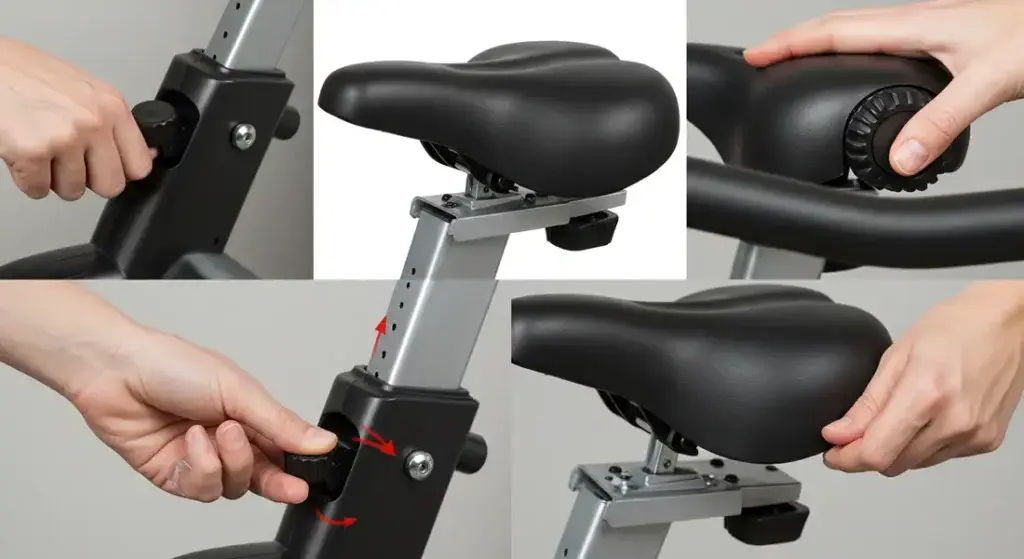
This is critical for comfort, effectiveness, and injury prevention.
- Seat Height: Must accommodate your leg length for proper extension.
- Seat Fore/Aft (Horizontal): Allows you to position your knee correctly over the pedal.
- Handlebar Adjustability: Height and sometimes reach. Being able to customize this greatly impacts upper body comfort. The more points of adjustment, the better you can tailor the bike to your body.
Console & Monitor
- Essential Metrics: At a minimum, you want to see: Time, Distance, Speed, and estimated Calories Burned.
- Heart Rate Monitoring: Often via grip sensors on the handlebars (less accurate) or compatibility with a chest strap (more accurate, often a better investment later).
- Pre-set Programs: Can add variety, but aren’t essential for a beginner. Focus on a clear, easy-to-read display first.
Flywheel Weight
Generally, a heavier flywheel (often found on spin bikes and higher-end uprights) provides a smoother, more consistent pedaling motion.
However, good engineering can make even moderately weighted flywheels feel smooth, especially with magnetic resistance.
Don’t get too hung up on massive numbers here as a beginner.
Build Quality & Stability
Look for the maximum user weight rating. A higher rating often indicates a sturdier build.
The bike should feel stable and not wobble when you’re pedaling.
Comfort Features
- Saddle (Seat): Especially important on upright bikes. Some are more cushioned than others. Don’t worry too much if the stock saddle isn’t perfect; you can often replace it or add a gel seat cover.
- Pedals: Should be large enough for your feet and ideally have straps to keep your feet secure.
What NOT to Overpay For (Initially)
As a beginner, you likely don’t need a massive HD touchscreen with countless streaming apps, super-advanced app connectivity, or hundreds of resistance levels.
Nail the basics of comfort, adjustability, and smooth resistance first.
You can always upgrade later if your passion for cycling ignites!
Setting Up Your New Exercise Bike – Your Blueprint for a Safe & Effective Ride
You’ve made your choice, the box has arrived – excitement!
But before you jump on, taking 10-15 minutes to set it up correctly is paramount.
Proper setup maximizes comfort, boosts workout effectiveness, and, most importantly, helps prevent injuries, especially to your knees and back.
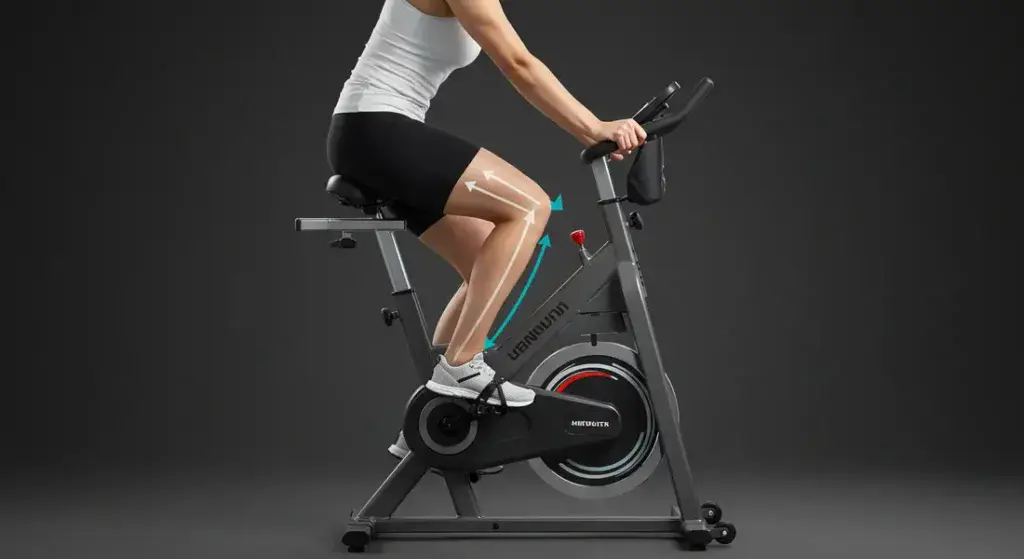
- Seat Height: This is the king of adjustments.
- The Heel Method: Sit on the bike and place your heel on the pedal at its lowest point in the rotation. Your leg should be almost completely straight, with just a very slight, soft bend in the knee.
- The Ball of Foot Method: When the ball of your foot is on the pedal at its lowest point, you should have a slight bend in your knee (around 5-15 degrees). Your leg should not be fully locked out, nor should it be excessively bent.
- Seat Fore/Aft Position (Horizontal):
- With your pedals parallel to the floor (one foot forward, one back), your forward knee should be directly above the spindle of that forward pedal (the axle the pedal rotates around). You can use a plumb line (a piece of string with a small weight) from the bony part just below your kneecap to check this.
- Handlebar Position:
- Upright Bikes: For beginners, position handlebars slightly higher than or level with the seat. This reduces strain on your back and wrists. As you get more comfortable, you can experiment with lower positions.
- Recumbent Bikes: Handlebars are usually in a fixed, comfortable position.
- Spin Bikes: Handlebar height and reach are often adjustable. Start with a more upright, comfortable position.
- Level the Bike: Ensure your bike is stable and doesn’t rock. Most have adjustable feet to accommodate uneven floors.
Personal Tip: Don’t be afraid to make micro-adjustments during your first few rides. What feels okay for 5 minutes might not for 20. A tiny tweak can make a world of difference.
Your First Pedal Strokes – Simple Exercise Bike Workouts to Get You Started
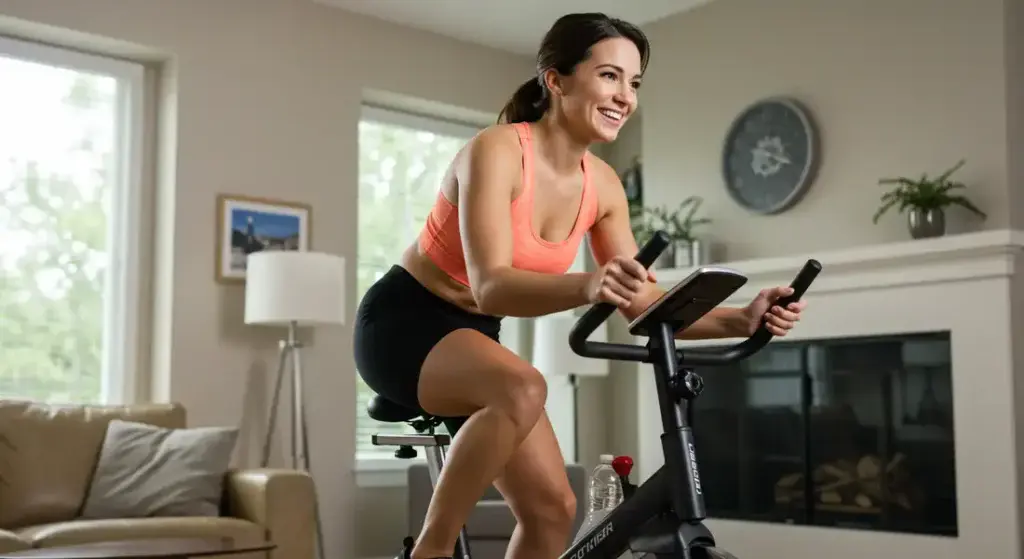
Alright, your bike is set up – it’s time for the maiden voyage!
The golden rule for beginners: start slow, focus on consistency, and listen to your body.
- Warm-Up (5 minutes): Always start with easy pedaling at very light resistance. This gets your blood flowing and prepares your muscles.
- Cool-Down (5 minutes): Equally important! Gradually reduce your pace and resistance to let your heart rate come down slowly. Follow up with some gentle stretches for your legs (quads, hamstrings, calves).
Understanding Effort – Rate of Perceived Exertion (RPE)
Instead of focusing purely on numbers, tune into how you feel. The CDC explains RPE on a scale, but simply:
- Easy: You can easily talk or sing.
- Moderate: You can talk, but it’s a bit breathy.
- Hard: Talking is difficult, just a few words at a time.
Sample Beginner Workouts
- The Steady Starter (15-20 minutes total):
- Warm-up: 5 minutes (easy RPE)
- Main Set: 5-10 minutes at a steady, comfortable pace (moderate RPE, light-to-moderate resistance). You should feel like you’re working, but not struggling.
- Cool-down: 5 minutes (easy RPE)
- Gentle Intervals (20 minutes total):
- Warm-up: 5 minutes (easy RPE)
- Main Set (repeat 3-4 times):
- 2 minutes at a comfortable pace (moderate RPE)
- 1 minute slightly increasing resistance or pace (still moderate, but top end of it)
- Cool-down: 5 minutes (easy RPE)
Frequency: Aim for 2-3 sessions per week initially. As you feel stronger, you can gradually increase the duration of your workouts by 5 minutes or add an extra session.
Beyond the Bike – Complementary Considerations for Beginners
While the bike is your star player, a few other things support your new fitness habit:
- Hydration: Keep a water bottle handy and sip throughout your workout and your day.
- Basic Nutrition: You don’t need a radical diet overhaul, but being mindful of fueling your body with whole foods will enhance your energy and results. (Always consult with a doctor or registered dietitian for personalized nutrition advice).
- Rest & Recovery: Your muscles build and repair during rest. Don’t underestimate the power of a day off or a good night’s sleep.
- Staying Motivated: This is key for long-term success. Find what works for you: great music, a podcast, watching a show, or setting small, achievable goals. Perhaps link this to your site’s “Staying Motivated When Working Out Alone” child page if it exists.
Common Beginner Pitfalls & How to Avoid Them
We’ve all been there! Here are a few common slip-ups:
- Too Much, Too Soon: Enthusiasm is great, but overdoing it can lead to burnout or injury. Gradual progression is sustainable.
- Ignoring Setup: A poorly adjusted bike is uncomfortable and inefficient. That initial 15 minutes of setup pays dividends.
- Inconsistency: Sporadic workouts won’t yield the results you want. Aim for a regular schedule, even if sessions are short.
- Comparing to Others: Your journey is unique. Focus on your own progress.
- Expecting Instant Miracles: Fitness is a marathon, not a sprint. Celebrate small victories and be patient with yourself.
Conclusion – Your Journey to Home Cycling Success Starts Now!
Choosing an exercise bike for beginners doesn’t have to be a complex equation.
By understanding the different types, focusing on essential features that match your needs, taking the time for proper setup, and starting with manageable workouts, you’re setting yourself up for a rewarding and sustainable home fitness experience.
The “best” exercise bike truly is the one that you feel comfortable on, that fits your budget, and, most importantly, that you will use consistently.
This guide has hopefully illuminated your path, transforming a potentially overwhelming decision into an exciting first step.
What are your thoughts? Are you considering an exercise bike, or do you have a beginner experience to share? Drop a comment – we’d love to hear from you!
Ready to take the next step?
- Explore our in-depth reviews of Top-Rated Exercise Bikes for Beginners.
- Dive deeper into Upright vs. Recumbent vs. Spin Bikes.
- Perfect your form with our Exercise Bike Setup Guide.
Welcome to the empowering world of home cycling!
